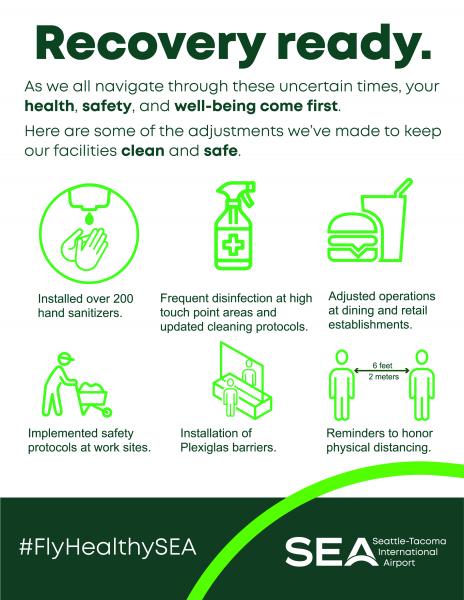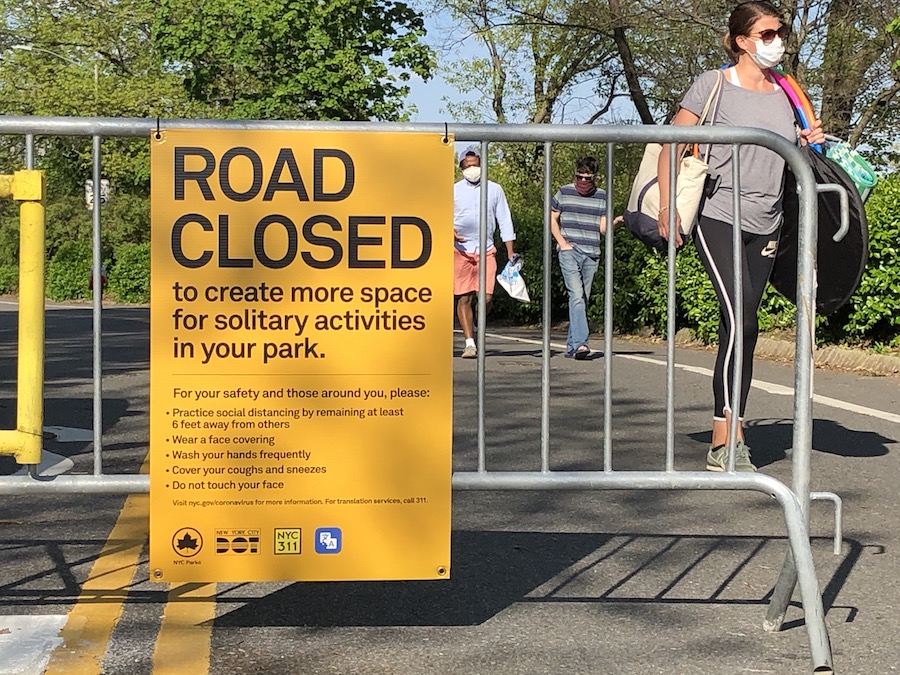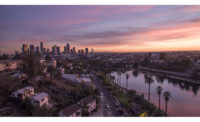Transportation facilities are essential to any broad reopening of the economy, but lowering the risk of COVID-19 transmission in mobility infrastructure is particularly vexing. Airports are literally the front line, says international engineering firm Arup’s Regine Weston, leader of airport planning in the Americas. They must “stop the next pandemic, because it will be spread through aviation.” In the short term, operators are taking steps to keep people safe—especially staff. Plexiglas partitions will protect ticketing and gate agents, because people working at airports can be “exposed to thousands of people going everywhere,” Weston explains.
Design interventions can help facilities reassure the public, through messaging designed to dispel fears (by spelling out disinfection procedures, for example) and enhanced wayfinding—including signage seen in the Seattle Airport, where lighthearted moose-antler graphics demarcate minimum physical distancing.

Some permanent—and costly—changes to airports are likely on the way. Bathrooms may be reconfigured to achieve greater separation between users and reduce contact with surfaces. Passengers may have to say goodbye to loved ones, and greet them on arrival, in repurposed parking-garage space intended to minimize the number of (possibly infected) people in the terminal. High-visibility devices may measure passengers’ body temperature, even though that is an imperfect proxy for infection. The prospect of being pulled aside may deter travelers who are slightly ill but “determined to see auntie,” Weston explained.
An article by the Copenhagen-based engineering firm Ramboll envisions “touchless triage at self check-in,” which could suspend the right to travel if vital signs show potential symptoms, as well as facial recognition technology that may replace transactions involving passports, paper tickets, and bag tags. While such tactics aim to reduce physical contact between people and choke points that produce lines, they also intensify debates about privacy and the potential for misuse of personal information.
Some airports may require arrival at an appointed time to minimize crowds, as efforts to maintain distancing between Transportation Security Administration (TSA) agents may require a decrease in the number of checkpoints. New TSA guidance also minimizes agent contact with luggage, so passengers whose bags set off alarms may have to return for a new screening after remedying the problem. This “backflow”—adding confusion, congestion, and possibly compromising distancing—“will have major facility impact,” says Weston.
TSA is incorporating @CDCgov guidance on #socialdistancing into checkpoint security operations. This includes increasing the distance between travelers, placing visual reminders of appropriate spacing & staggering security lanes in use where feasible. Our #TSAofficers thank you! pic.twitter.com/XjAJc2Tn0V
— TSA (@TSA) May 19, 2020
Arup is using a proprietary tool called MassMotion that analyzes such crowd-flow scenarios. It is applicable not only to airports but to any facility that attracts crowds. Margaret Newman, an integrated planning principal at the firm, has used the tool to analyze the implications of reducing elevator-car capacity in high rises. “People backing up in the lobby, not the elevator, was the problem,” she explains. “It showed us that staggering work times can have a powerful effect in managing crowds.”

The pandemic is converging efforts to redesign streets to better balance pedestrians (especially where sidewalks are too narrow for proper distancing) and autos. “Slow” or “Open Streets” programs give people greater access to daylight, fresh air, and physical activity. The high perceived risk of public transportation may lead to expanded bike-lane networks. Cash-strapped restaurants are promoting the use of street space to expand properly distanced seating, what former New York restaurateur and current cycling advocate Henry Rinehart calls “economic development in a public health crisis.” Restaurants flowing outside will also enliven streetscapes blighted by empty storefronts, according to Rinehart—the “retail apocalypse” that is expected to worsen as the crisis drags on.
As the behavior of the coronavirus is better understood, evaluations of risk can be more exacting. A blog post by Erin Bromage, an infectious-disease specialist at the University of Massachusetts, Dartmouth, has gone viral by emphasizing the greater likelihood of infection with intensity of exposure multiplied by time. Thus, a brief elevator ride or minutes-long trip on a crowded bus may pose little risk, giving some comfort to those who can’t avoid crowds on the way to work. (Safe longer trips may await ventilation that is filtered, decontaminated, or supplied in such quantity that it can dilute viral loads.) The CDC does not use the infection formula in its guidance; the information to truly pinpoint risk is still lacking. Uncertainty may continue to slow transportation’s contribution to recovery.
Thanks for helping stop the spread of #COVID19.
— Seattle-Tacoma Intl. Airport (@flySEA) May 27, 2020
SEA ❤️ your health! Please wear your face covering at the airport. If you forget, just reach out to our staff.
We’re here to help! #FlyHealthySEA pic.twitter.com/jwCCD5SCBc



Post a comment to this article
Report Abusive Comment